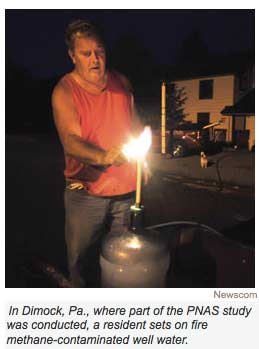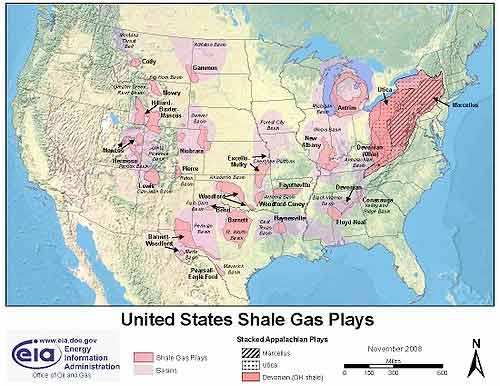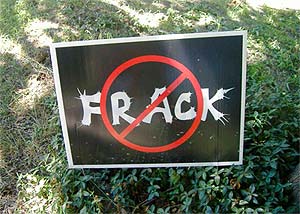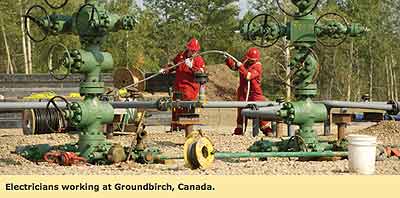Biblio
The Safe Drinking Water Act (SDWA) is the main federal law that ensures the quality of Americans' drinking water. Under SDWA, EPA sets standards for drinking water quality and oversees the states, localities, and water suppliers who implement those standards.
SDWA was originally passed by Congress in 1974 to protect public health by regulating the nation's public drinking water supply.
The law was amended in 1986 and 1996 and requires many actions to protect drinking water and its sources: rivers, lakes, reservoirs, springs, and ground water wells. (SDWA does not regulate private wells which serve fewer than 25 individuals.)
Web Article contains links to legal, scientific, and contact information.
See: Safe Drinking Water Act 101 | Online Training | Drinking Water Academy
Sanjel is one of the companies the U.S. House Committee on Energy and Commerce is investigating on the potential environmental impacts from hydraulic fracturing.
"Sanjel Corporation is a privately owned, Canadian-based, international oilfield service company with over two and a half decades of industry experience. As a major competitor in the global oil and gas market and the largest privately owned oilfield service company in Canada, Sanjel offers five specialized service lines including Acidizing, Cementing, Coiled Tubing, Fracturing and Nitrogen."
Congressman Scalise serves on the Subcommittee on Energy and Environment. Cap-and-Trade Hinders Job Growth, By Rep. Steve Scalise, Published in Roll Call February 8, 2010.
"...our state has seen success onshore by using safe, responsible and environmentally sound energy production technologies such as hydraulic fracturing.
Recently, this new technology was used to produce oil and gas from shale rock in Haynesville, La. This project helped create 32,742 new jobs within the state and added $3.2 billion to our economy through lease and royalty payments."
Congressman Scalise serves on the Subcommittee on Energy and Environment. Monday, December 7, 2009.
"Regulation of green house gases will put millions of American jobs in danger."
Washington, DC -- Congressman Steve Scalise (R-LA) today made the following statement after the U.S. Environmental Protection Agency (EPA) announced that they have declared carbon dioxide (CO2) along with five other gases as dangerous pollutants.
“The EPA's decision today is another example of this Administration’s liberal agenda that is killing jobs. What makes the EPA’s decision even more reckless is the fact that it is based on corrupt science that has recently been exposed by the ‘Climate gate scandal,’” Scalise said.
“At a time when the American people are asking ‘where are the jobs,’ the Obama administration continues to promote policies that run jobs out of our country while adding unprecedented debt onto the backs of our children and grandchildren.”
Schlumberger is one of the large companies being investigated by the U.S. House Energy and Commerce Committee to see if the gas extraction method known as hydraulic fracturing, or fracking, is a hazard to groundwater drinking supplies.
Schlumberger employs over 77,000 people of more than 140 nationalities working in approximately 80 countries.
Reuters reported on May 19, 2010 that personnel from oilfield giant Schlumberger left BP’s Deepwater Horizon only hours before it exploded. Read the article here.
Although "Flaring" was used extensively in the Gulf of Mexico aftermath of the BP Deepwater Horizon explosion in April, 2010, Schlumberger published a 2002 report that recommends zero flaring in the Middle East.
The World Bank estimates that over 150 billion cubic metres of natural gas are flared or vented annually, an amount worth approximately 30.6 billion dollars, equivalent to 25 percent of the United States’ gas consumption or 30 percent of the European Union’s gas consumption per year. See World Bank, December 14, 2009. "World Bank, GGFR Partners Unlock Value of Wasted Gas".
See: Renee Schoof and Marisa Talylor. June 11, 2010. McClatchy. "Plan to burn excess oil from BP well raises health questions."
See: Energy & Commerce Committee Investigates Deepwater Horizon Rig Oil Spill
"Schlumberger Mississippi Canyon Block 252 Timeline". (PDF)
On April 18, 2010, a Schlumberger wireline cased hole crew arrives on Transocean Deepwater Horizon. Specifically, BP contracted with Schlumberger to be available to perform a cement bond log and set a bridge plug and/or cement retainer, should BP request those services.
At approximately 7:00 a.m., BP informs Schlumberger crew that no wireline cased hole services will be requested and BP sends Schlumberger crew home.
At approximately 11 :15 a .m., on April 20, 2010, the day of the BP well explosion, the Schlumberger crew departed Transocean Deepwater Horizon on regularly scheduled BP helicopter flight.
At 10:56 EDT, the fire on Deepwater Horizon started. It burned for more than a day and sank April 22, leading to 11 deaths and the largest oil spill in U.S. history.
Schlumberger failed to advise public officials on how BP's actions, declining a wireline cased hole service might have prevented this disaster.
How can government regulators require that private contractors in the oil and gas industry blow the whistle on potentially global disasters? (Neil Zusman, 2010-08-13.)
See: Publication: Middle East & Asia Reservoir Review
Volume: No. 3, 2002
Publication Date: 01/01/2002
An important issue in protecting the environment of the Gulf, which is no less fragile than elsewhere in the world, is the effect of hydrocarbon flaring from oil production operations. This causes many forms of pollution – noise, toxic gases, soot, acid rain and the production of carbon dioxide, the latter is one of the primary causes of global warming. In this article, Alp Tengirsek and Nashat Mohamed explain the progress of a project in Abu Dhabi that has already eliminated oil flaring during testing and production, with the ultimate aim of eliminating all hydrocarbon flaring within a year.
See: Stanley Reed. "The Stealth Oil Giant: Why Schlumberger, long a hired gun in oil-field services, is becoming a major force and scaring Big Oil". Business Week. 2008-01-03
For the first time, a scientific study, has linked natural gas drilling and hydraulic fracturing with a pattern of drinking water contamination so severe that some faucets can be lit on fire.
The peer-reviewed study, published today in the Proceedings of the National Academy of Sciences, stands to shape the contentious debate over whether drilling is safe and begins to fill an information gap that has made it difficult for lawmakers and the public to understand the risks...
They were alarmed by what they described as a clear correlation between drilling activity and the seepage of gas contaminants underground, a danger in itself and evidence that pathways do exist for contaminants to migrate deep within the earth.
"We certainly didn't expect to see such a strong relationship between the concentration of methane in water and the nearest gas wells. That was a real surprise," said Robert Jackson, a biology professor at Duke and one of the report's authors.
See: U.S. Congress. Committee on Space, Science, and Technology. "Hearing Highlights Lack of Objectivity in Draft EPA Fracking Study--No Evidence of Drinking Water Contamination from Fracking, Witnesses Say". May 11, 2011
Methane Fouls Water
See also: Ritter, Stephen K., and Glenn Hess. “Methane Fouls Well Water.” Chemical & Engineering News, May 16, 2011.
A study by Duke University researchers provides the first scientific confirmation of a link between natural gas drilling in organic-rich shale deposits and methane-contaminated residential well water. The study’s release has rekindled the debate among the oil and gas industry, environmental advocacy groups, and lawmakers over health and safety concerns about natural gas drilling methods, which are largely unregulated.
When environmental chemist Robert B. Jackson and coworkers at Duke University sampled 68 residential wells in south central New York and northeastern Pennsylvania, they found no evidence that chemicals used in hydraulic fracturing—or fracking, the most widely used drilling method to extract methane from shale beds—had percolated into drinking water, as some fear.
The scientists instead found that water wells within 1 km of active gas extraction sites had methane levels of 19.2 mg/L on average, compared with 1.1 mg/L on average in wells in inactive areas farther from drilling sites (Proc. Natl. Acad. Sci. USA, DOI: 10.1073/pnas.1100682108). The federal methane action level is 10 mg/L, above which ventilation is recommended for safety...
Full Text:
Osborn, Stephen G., Avner Vengosh, Nathaniel R. Warner, and Robert B. Jackson. “Methane contamination of drinking water accompanying gas-well drilling and hydraulic fracturing.” Proceedings of the National Academy of Sciences 108, no. 20 (May 17, 2011): 8172 -8176.
Red tire marks line the roads leading up to the extinct Somlo volcano, home to Hungary’s smallest wine region and only a few miles from the worst environmental disaster in the country’s history.
It has been almost two weeks since a concrete dam holding back millions of gallons of toxic sludge burst, sweeping two villages along with it and killing nine people. The fields are still red, eerily outlined in chalky white — the gypsum that emergency crews used to try to neutralize the caustic grime...
...What exactly is this sludge stored in reservoirs across this part of Hungary by the hundreds of millions of cubic feet?
...The sinister sound of the sludge sloshing around the edge of the shovel blade lingers in the ear, and makes the initial lack of reliable information more painful.
Soon after the spill, the Hungarian Academy of Sciences declared that the red sludge was nontoxic. The chief executive of MAL went on camera to say it was a completely harmless substance, that it could simply be washed away with water.
They were quickly proved wrong. The first responders suffered severe burns; apparently no one warned them that the sludge had a pH of 13, as caustic as lye.
The gap between the official statements and the reality of people dying seemed to widen the crack in the wall. For many, it brought to mind the time, thought long past, when so much of life in Hungary was defined by rumors and lies, when everything was a game of pretend and make-believe.
By JOHN M. BRODER, New York Times, January 21, 2010. "In a direct challenge to the Environmental Protection Agency’s authority, Senator Lisa Murkowski, Republican of Alaska, introduced a resolution on Thursday to prevent the agency from taking any action to regulate carbon dioxide and other climate-altering gases."
Senator Lisa Murkowski is challenging the authority of the Environmental Protection Agency.
Shale gas has plenty of detractors.
Environmentalists say fracking, a process in which drillers blast water into a well to shatter rock and unleash the gas, threatens pristine watersheds. Dish, a hamlet of 180 residents north of Fort Worth, Texas, has almost as many wells, compressors and pipelines as people.
‘Children, Old People’
Last year, the Texas Commission on Environmental Quality found benzene, which it classifies as a carcinogen, at 10,700 times the safe long-term exposure limit next to a well 6 miles (10 kilometers) west of town on which a valve had been left open.
“We have children, old people, pregnant women,” Mayor Calvin Tillman says. “They’re not supposed to be subjected to toxins.”
Switzer, who moved to Dimock Township, Pennsylvania, to build a $350,000 dream home with her husband, Jimmy, in 2004, had no idea how shale gas would consume her village of 1,400.
She says she found so much methane in her well that her water bubbled like Alka-Seltzer. Neighbor Norma Fiorentino says methane in her well blew an 8-inch-thick (20-centimeter-thick) concrete slab off the top. The $180 bonus Cabot paid to drill on Switzer’s 7.2 acres (2.9 hectares) and the $900 in royalties she gets each month don’t compensate, she says.
‘Beads and Baubles’
“I feel like one of the Indians who sold Manhattan for beads and baubles,” she says.
The economics of shale don’t look great right now for big companies either. Natural gas prices plunged to $2.41 per MMBtu in September 2009 from $13.69 in July 2008 as the recession cut demand while drilling accelerated. On May 24, gas traded at $4.04.
Includes related videos: John Hanger, secretary of Pennsylvania’s Department of Environmental Protection, talked with Bloomberg's John Lippert in Harrisburg, Pennsylvania, on May 13 about regulation of shale-gas drilling operations in the commonwealth.
Shale gas in the United States is rapidly increasing as a source of natural gas. Led by new applications of hydraulic fracturing technology and horizontal drilling, development of new sources of shale gas has offset declines in production from conventional gas reservoirs, and has led to major increases in reserves of US natural gas.
Please note that information taken from Wikipedia should be verified using other, more reliable sources. It is a good place to start research, but because anyone can edit Wikipedia, we do not recommend using it in research papers or to obtain highly reliable information.
EnergyBulletin.net is a clearinghouse for information regarding the peak in global energy supply. It is published by Post Carbon Institute whose goal is to provide a roadmap for a transition to a resilient, equitable, and sustainable world by arming individuals, communities, businesses, and governments with the information and resources they need to understand and take action.
Shale Gas Shenanigans
...These shale gas producers are an asset play. And this outcome obviously benefits the Wall Street banks who lend them money. Indeed, this is their exit strategy from the unprofitable drilling treadmill they are currently on. If shale gas production can be said to be in a bubble, this is where that bubble lies. And the strategy is working! Rigzone reports on the acquisition frenzy...
Energy Bulletin is maintained by three editors, Simone Osborn, Kristin Sponsler, and Bart Anderson, based respectively in Bristol, UK, and California USA. Adam Grubb (writing as Adam Fenderson) and Liam Cranley of Melbourne, Australia, founded Energy Bulletin in 2004.
On January 14, 2009, Energy Bulletin was adopted as a core program by the Post Carbon Institute. Except for PCI, Energy Bulletin is unaffiliated with any private, government, or institutional body.
"With the rapid development of the shale plays across the U.S., there was a massive influx of lease purchases which drove companies with cash into a bidding frenzy," said Ryan. (Neal Ryan, managing partner at Ryan Oil & Gas Partners LLC.)
"Now many of those companies are being forced to continue drilling plans formulated for a much higher market price in order to protect those lease investments," he said.
That's "a dangerous spot to be in because the domestic market doesn't need this gas right now, but companies are stuck having to protect their capital investment," he said.
Shaleshock Action Alliance is a movement that works toward protecting our communities and environment from exploitative gas drilling in the Marcellus Shale region.
Shaleshock is an alliance of Working Groups which include people who have signed leases, not signed leases, who have been compulsorily integrated, and people who don't own land.
See: A collection of websites and listservs edited by Shaleshock.
See: Updated Calendar of Events For New York and Pennsylvania.
See: Driling 101 - background information on hydraulic fracturing.
On May 28, 2010, Bloomberg.com reported that Royal Dutch Shell Plc agreed to buy closely held East Resources Inc., for about $5 billion.
East Resources will no longer be a U.S. corporation.
Author Ken Saro-Wiwa was a member of the Ogoni people, an ethnic Nigerian minority whose hometown, Ogoniland, in the Niger Delta has been targeted for crude oil extraction since the 1950s and which has suffered extreme and unremediated environmental damage from decades of indiscriminate oil waste dumping. Saro-Wiwa, initially as spokesperson, and then as President, of the Movement for the Survival of the Ogoni People (MOSOP), led a nonviolent campaign against environmental degradation of the land and natural waters of Ogoniland by the operations of multinational oil companies, especially Shell.
At the peak of his non-violent campaign, Saro-Wiwa and the other members of the Movement for the Survival of the Ogoni People were arrested, hastily tried by a special military tribunal, and hanged in 1995 by the Nigerian military government of General Sani Abacha, all on charges widely viewed as entirely politically motivated and completely unfounded. Their executions provoked international outrage and resulted in Nigeria's suspension from the Commonwealth of Nations.
Shell has been brought on trial in New York with the accusation of having collaborated with the military executions, and in June 2009, it has settled out of court for US $15 million to bring the case to an end.
See: Ed Pilkington. "Shell pays out $15.5m over Saro-Wiwa killing." The Guardian. June 9, 2009.
See: Jad Mouawad. "Shell to Pay $15.5 Million to Settle Nigerian Case." NYT. June 8, 2009.
Shell Gas Flaring is Illegal Says Benin City High Court
See: Poison Fire
Why the delay in remediation?
See: Shell Oil statement. Flaring in Nigeria.
The gas gathering programme has been delayed by funding shortfalls from the major government shareholder and security concerns which meant it was not safe for staff to work in large parts of the delta for long periods of time.
However, Shell Petroleum Development Company of Nigeria Limited (SPDC) and its partners continue to invest in reducing flares and have resumed work on many delayed projects and started new ones. SPDC is currently improving or installing associated gas gathering (AGG) facilities at 19 flowstations.
In late 2009, projects were sanctioned to install AGG facilities at a further seven flowstations. In total these projects represent an investment of over $2 billion. When all this work is completed it will cover more than 75% of SPDC’s production potential.
Shell and Hydraulic Fracturing
At Shell we have decades of experience with this technology and we continue to follow strict measures to protect drinking water supplies.
Sierra Club Finger Lakes Group Gas Information Page.
Website includes Editorial by Gene Stolfi, Winter 2009. "Marcellus Shale —To Drill or Not To Drill?" Finger Lakes Group ExCom, Steuben Environmental Management Council
This web page includes links to scientific background information, Documents of Interest: "MSDS Data Sheets from NYS DEC for 48 Fracking Chemicals used in NY".




























